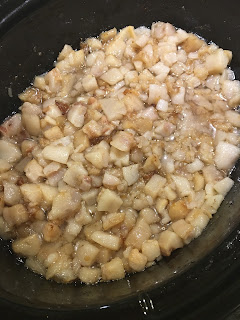Render Lard the Easy Way!
I was recently given about 8 pounds of hog fat by a friend of mine who had just butchered. My work schedule was currently hectic, and I knew it would be hard to find the time to laboriously cook and stir for hours to render out the lard. But in my opinion, cooking and especially baking with lard is the best, so I considered my options. Now, I've always rendered lard the old-fashioned way: on a stove top with large kettles. But I had read accounts of folks using their slow cookers instead of kettles, and one thing that had stuck in my memory was that you don't need to constantly be stirring the pot because cooking the hog fat on low in a slow cooker virtually guarantees no burning. I figured I'd give it a try, and I'm so glad I did because the results were spectacular!
 |
| Snow White Lard |
Here's how to render out gorgeous, mild lard:
First, cut off much of the meat that might be still clinging to the fat (no need to obsess about this), and then cut the fat into small pieces, about 1 inch square. Place them in your slow cooker and add about 1/8 cup of water (if you have a full pot of fat pieces), or possibly less if you don't have a full pot. You can start by turning the slow cooker on high to heat everything up, but move the setting to low after about 30-60 minutes and keep it on low for the rest of the time.
Here's what mine looked like:
 |
| Pieces of hog fat in my slow cooker beginning to melt. |
 |
| Filtering the lard |
Just keep up with this process until you aren't getting anymore melted fat and what's left in the slow cooker has turned brown. Those brown chunks are cracklings, and lots of folks eat them and consider them a real treat. I just spread out the cracklings on large baking sheets, give them a shake of salt, and then bake them in a 350 degree oven for about 20 minutes, stirring them once or twice while they are crisping up.
 |
| Cracklings! |
 |
| Lard, ready to refrigerate and use when needed. |
If you don't raise your own hogs, check around in your community to see if you can find a local hog farmer who might be willing to give you fat, sell it to you, or let you take it if you give him or her half of the lard that you render. Alternatively, if you have a local meat processor or market, they might have hog fat to give or sell to you also.


















